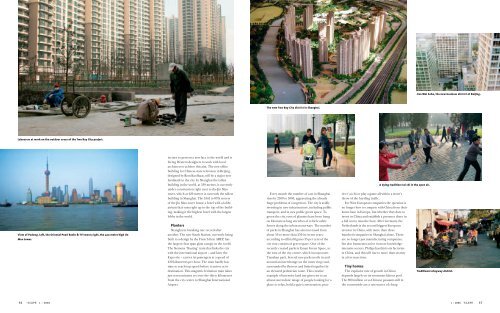LANDSCAPE ARCHITECTS - scape - Landscape architecture and ...
LANDSCAPE ARCHITECTS - scape - Landscape architecture and ...
LANDSCAPE ARCHITECTS - scape - Landscape architecture and ...
You also want an ePaper? Increase the reach of your titles
YUMPU automatically turns print PDFs into web optimized ePapers that Google loves.
Labourers at work on the outdoor areas of the Two Bay City project.<br />
View of Pudong. Left, the Oriental Pearl Radio & TV tower; right, the 420 metre high Jin<br />
Mao tower.<br />
tecture to present a new face to the world <strong>and</strong> is<br />
hiring Western designers to work with local<br />
architects to achieve this aim. The new office<br />
building for Chinese state television in Beijing,<br />
designed by Rem Koolhaas, will be a major new<br />
l<strong>and</strong>mark in the city. In Shanghai the tallest<br />
building in the world, at 539 metres, is currently<br />
under construction right next to the Jin Mao<br />
tower, which at 420 metres is currently the tallest<br />
building in Shanghai. The 53rd to 87th storeys<br />
of the Jin Mao tower house a hotel with a lobby<br />
atrium that runs right up to the top of the building,<br />
making it the highest hotel with the largest<br />
lobby in the world.<br />
Planters<br />
Shanghai is breaking one record after<br />
another. The new South Station, currently being<br />
built to a design by the French firm AREP, has<br />
the largest clear span glass canopy in the world.<br />
The Siemens ‘floating’ train that links the city<br />
with the international airport – <strong>and</strong> later the<br />
Expo site – carries its passengers at a speed of<br />
430 kilometres per hour. The train hardly has<br />
time to reach top speed before it arrives at its<br />
destination. This magnetic levitation train takes<br />
just seven minutes to cover the thirty kilometres<br />
from the city centre to Shanghai International<br />
Airport.<br />
The new Two Bay City district in Shanghai.<br />
Every month the number of cars in Shanghai<br />
rises by 2500 to 5000, aggravating the already<br />
huge problems of congestion. The city is avidly<br />
investing in new infrastructure, including public<br />
transport, <strong>and</strong> in new public green space. To<br />
green the city, rows of planters have been hung<br />
on kilometres-long stretches of vehicle safety<br />
fences along the urban motorways. The number<br />
of parks in Shanghai has also increased from<br />
about 50 to more than 250 in recent years:<br />
according to official figures 35 per cent of the<br />
city now consists of green space. One of the<br />
recently created parks is Yanan Green Space, to<br />
the west of the city centre, which incorporates<br />
Tianshan park. Several new parks nestle in <strong>and</strong><br />
around an interchange on the inner ring road,<br />
surrounded by flyovers <strong>and</strong> linked together by<br />
an elevated pedestrian route. This creative<br />
example of intensive l<strong>and</strong> use gives rise to an<br />
almost surrealistic image of people looking for a<br />
place to relax, hold a quiet conversation, prac-<br />
tice t’ai chi or play a game all within a stone’s<br />
throw of the hurtling traffic.<br />
For West European companies the question is<br />
no longer how to compete with China from their<br />
home base in Europe, but whether they dare to<br />
invest in China <strong>and</strong> establish a presence there in<br />
a bid not to miss the boat. After Germany, the<br />
Netherl<strong>and</strong>s is the second biggest European<br />
investor in China, with more than three<br />
hundred companies in Shanghai alone. These<br />
are no longer just manufacturing companies,<br />
but also businesses active in more knowledgeintensive<br />
sectors. Philips has thirty-six factories<br />
in China, <strong>and</strong> this will rise to more than seventy<br />
in a few years time.<br />
Tiny homes<br />
The explosive rate of growth in China<br />
depends largely on its enormous labour pool.<br />
The 800 million or so Chinese peasants still in<br />
the countryside are a vast source of cheap<br />
A dying tradition: tai chi in the open air.<br />
Jian Wai Soho, the new business district of Beijing.<br />
Traditional alleyway district.<br />
36 ’SCAPE 1 / 2006 1 / 2006 ’SCAPE 37



